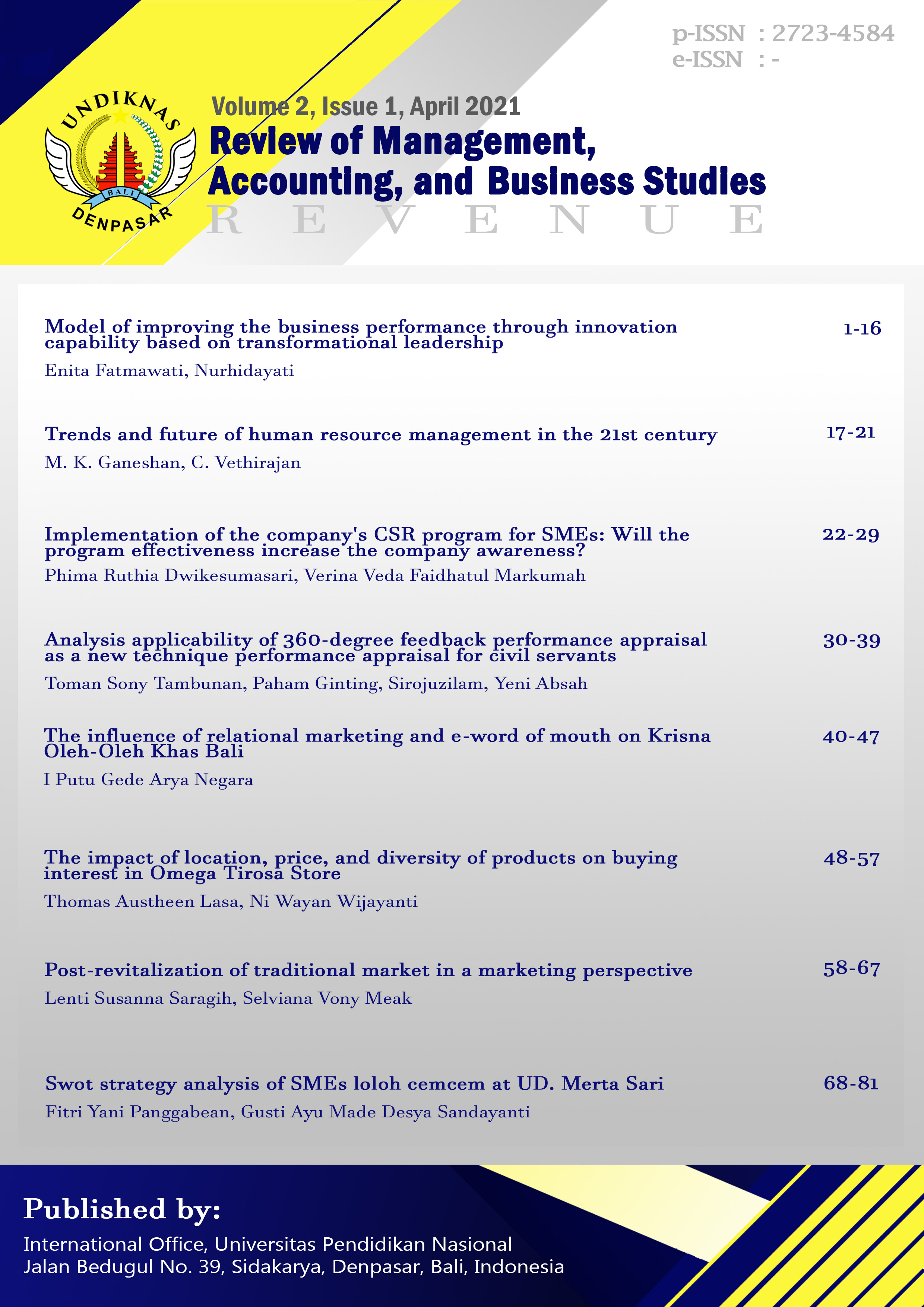Implementation of the company's CSR program for SMEs: Will the program effectiveness increase the company’s awareness?
DOI:
https://doi.org/10.38043/revenue.v1i2.3644Keywords:
Corporate Social Responsibility (CSR), Program Effectiveness, Company Awareness, Small Medium Enterprises (SMEs)Abstract
Firms wield considerable influence over development as well as their contribution to regional economies, job creation, and business development. Their contribution to development can be understood from the perspective of the Corporate Social Responsibility (CSR) program. The impact of firms’ CSR initiatives and brand awareness of the organization is a critical issue that needs to be addressed. Company X is one of the service firms engaged in business consulting. Company X's primary CSR program is CSR Program A, which focuses on empowering SMEs in Surabaya, Indonesia, to excel in their respective industries. The researcher employed a qualitative approach in this study, conducting interviews with five informants to elicit information regarding a company's CSR program for SMEs. The results were: (1) the CSR programs implemented were effective and met the demands of SMEs. The company's commitment to optimizing the implementation of this program's action plan will boost program members' loyalty; and (2) initially, SMEs owners were unaware of the CSR program provider businesses in which they participated. However, while implementing the program, the corporation provided mentors and presenters throughout the course of the program. In turn, resulting in the gradual formation of the second level of company consciousness. Additionally, the presence of a comprehensive CSR program action plan enhances the program's effectiveness from the perspective of program participants, ensuring that CSR programs are associated with a favorable company image (top level of awareness). Future research can expand this analysis by conducting quantitative research to boost the generalizability of the research findings. Prepositions can be used to construct hypotheses.
References
Articles
Aaker, D. A. (1996). Measuring brand equity across products and markets. California Management Review, 38(3), 102-120.
Bacinello, E., Tontini, G., & Alberton, A. (2020). Influence of maturity on corporate social responsibility and sustainable innovation in business performance. Corporate Social Responsibility and Environmental Management, 27(2), 749-759.
Balmer, J. M. T., & Gray, E. R. (2003). Corporate brands: what are they? What of them? European Journal of Marketing, 37(7/8), 972-997.
Bariball, K. L., & While, A. (1994). Collecting data using a semi-structured interview: a discussion paper. Journal of Advanced Nursing, 19, 328-335.
Budiani, N. W. (2007). The effectiveness of the youth program for youth unemployment Eka Taruna Bhakti, Sumerta Kelod Village, East Denpasar District, Denpasar City. Journal of Economics and Social INPUT. 2(1).
Burke, L., & Logsdon, J. M. (1996). How corporate social responsibility pays off. Long Range Planning, 29(4), 495-502.
Caroll, A. B. (1979). A three-dimensional conceptual model of corporate performance. Academy of Management Review, 4(4), 497-505.
Cropanzano, R., & Mitchell, M. S. (2005). Social exchange theory: An interdisciplinary review. Journal of Management, 31(6), 874.900.
Davies, G., Chun, R., Vinhas D. S. R., & Roper, S. (2004). A corporate character scale to assess employee and customer views of the organization reputation. Corporate Reputation Review, 7(2), 125–146.
Del, G. T., Stranieri, S., Caracciolo, F., Ricci E. C., Cembalo, L., Banterle, A., & Cicia, G. (2018). Corporate social responsibility certifications influence consumer preferences and seafood market prices. Journal of Cleaner Production, 178, 526-533. https://doi.org/10.1016/j.jclepro.2017.12.276
Fordham, A. E., Robinson, G. M., Cleary, J., Blackwell, B. D., & Van, L. J. (2018). Use of a multiple capital framework to identify improvements in the CSR strategies of Australian resource companies. Journal of Cleaner Production, 200, 704-730. https://doi.org/10.1016/j.jclepro.2018.07.184
Harcourt, H., & Ubaka, O. J. (2018). Brand awareness and market performance of food and beverage firms in River State, Nigeria. International Journal of Business & Law Research, 6(4), 1-10.
He, H., & Li, Y. (2011). CSR and service brand: The mediating effect of brand identification and the moderating effect of service quality. Journal of Business Ethics, 100(4),673-88.
Kallio, H., Pietila, Anna-Maija, & Johnson, M. (2016). Systematic methodological review: developing a framework for qualitative semi-structured interview guide. Journal of Advanced Nursing, 72(12), 2954-2965. https://doi.org/10.1111/jan.13031.
Kaman, Z. K., & Othman, Z. (2018). Caroll’s model and Ghandi’s four forces model: The choice of going green. The European Proceedings of Social and Behavioral Sciences, 297-305. https://dx.doi.org/10.15045/epsbs.2018.07.02.32
Mattera, M., Baena, V., & Cerviño, J. (2012). Analyzing social responsibility as a driver of a firm’s brand awareness. Procedia-Social and Behavioral Sciences, 1121-1130.
Middlemiss, N. (2003). Authentic not cosmetic: CSR as a brand enhancement. J Brand Manag, 10, 353–361 (2003). https://doi.org/10.1057/palgrave.bm.2540130
Mochales, G., & Blanch, J., (2021). Unlocking the potential of CSR: An explanatory model to determine the strategic character of CSR activities. Journal of Business Research, 140, 310-323. https://doi.org/10.1016/j.busres.2021.11.002
Nan, X., & Kwangjun, H. (2007). Consumer responses to corporate social responsibility (CSR) initiatives: Examining the role of brand-cause fit in cause-related marketing. Journal of Advertising, 36(2), 63-74.
Popoli, P. (2011). Linking CSR strategy and brand image: Different approaches in local and global markets. Marketing Theory, 11(4), 419-433.
Suki, N. M., Suki, Norbayah M., Azman, & Nur, S. (2016). Impacts of corporate social responsibility on the links between green marketing awareness and consumer purchase intentions. Procedia Economics and Finance, 262-268.
Youssef, B. K., Leicht, T., Pellicelli, M., & Kitchen, P.J. (2018). The importance of corporate social responsibility (CSR) for branding and business success in small and medium-sized enterprises (SMEs) in a business-to-distributor (B2D) context. Journal of Strategic Marketing, 26(8), 723-739.
Books
Aaker, D. A. (1991). Managing brand equity, capitalizing on the value of brand name. Free Press.
Bergstrom, F. W. (2003). Organic Syntheses Database Online. Wiley Online Library. https://doi.org/10.1002/0471264180.os900.08
Googins, B. K., Mirvis, P. H., & Rochlin, S.A. (2007). Beyond good company: next generation corporate citizenship. Palgrave Macmillan.
Handayani. (2010). Brand operation. Esensi Erlangga Group.
Travis, D. (2000). Emotional branding-how successful brands gain the irrational edge. Roseville, Prime Venture.
Downloads
Published
How to Cite
Issue
Section
License
Copyright (c) 2021 Phima Ruthia Dwikesumasari, Verina Veda Faidhatul Markumah

This work is licensed under a Creative Commons Attribution-ShareAlike 4.0 International License.











